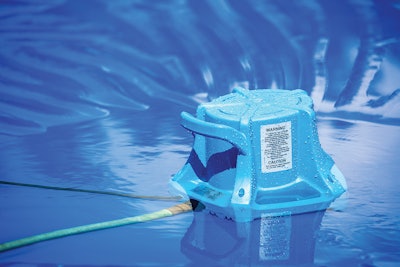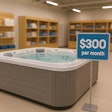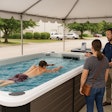
Pool cover manufacturers include a cover pump with each cover sold in the United States. That industry standard makes a lot of sense, because pumps allow pool owners to maintain clean covers that fit properly and — in the case of automatic pool covers — help prevent rainwater and snowmelt from entering the cover box.
But death and the taxman come for us all eventually, and the day arrives when that pump needs replacing. When that happens, it would seem like a good opportunity for dealers, as cover pumps are an ideal product to consistently stock and even promote. But — according to Josh Clark, business unit sales manager for pool, outdoor living and hydroponics for Franklin Electric — you’d be surprised.
“When I go to stores and visit with dealers, the biggest issue I run into is that they just don’t have [a pool cover pump] on hand, and that means they’re losing sales,” Clark says. “It’s imperative that they do carry it, because it’s just like anything: If you have a customer that walks in your store, and you don’t have it, they’re going to go somewhere else. And if they buy a pump somewhere else, they also could buy some of the other products you sell at that other location.”
That said, dealers can be savvy about marketing and proactively selling pool cover pumps, regardless of brand. One such dealer is Mike Panella, chief executive officer of Swimming Pool Services Inc., an AQUA 100 retailer based in Waukesha, Wis. His hometown got drenched this spring, with record rainfall totals — nearly 16 inches over three months — that the region hadn’t experienced since 1933. The rain continued throughout the summer, too, making it easy for Mike Panella to talk with customers about pool cover pumps.
“People are constantly coming in and telling us how much water they drained out of their pool. So naturally, we’ll ask, ‘Oh, what kind of pump do you use to drain it?’
“They shouldn’t really be getting rain in their pool, but maybe they left the cover off and some got in. We’ll remind them they can just use their cover pump to drain some of that water, and then they realize that’s a smart move.”
Every homeowner with a pool cover also should have a pool cover pump handy. After all, cover manufacturers are required to include one with each cover sold in the United States. That industry standard makes a lot of sense, because pumps allow pool owners to maintain clean covers that fit properly and — in the case of automatic pool covers — help prevent rainwater and snowmelt from entering the cover box. Plus, as Panella points out, cover pumps also can help remove excess water in the pool or even be used to drain a hot tub.
While the cover pump comes with the cover as an ancillary product, Panella and his sales team stress that its usage is not optional.
“We tell our customers that the cover is the most expensive line item they’ll have with the pool. We say, ‘We won’t ask you to do much, but you need to put this blue thing out on the cover when it’s over the pool. That will help protect your investment,’” Panella says, adding that the dealership also includes the CoverBlast pool cover pump attachment with the initial cover purchase. The hose replacement nozzle allows pool owners to discharge water from the cover safely and conveniently.
“If you don’t present using [the pump] as an option, people aren’t going to question it,” he adds. “It’s no different than if your pool has a sand filter; you have to backwash it. It’s all about setting expectations: ‘Okay, you have this piece of equipment, this is how it works, and this is how you take care of it.’”
The store has a small indoor pool that employees use to test pool cover pumps customers bring in when they aren’t working properly. Often, leaves or other debris might be preventing it from operating. In that case, staff members explain how to remove that buildup material. Some pool cover pumps include a cover plate at the bottom that allows for easy spray cleaning. Pine needles, for example, can get stuck on the float switch that determines when the pump should turn on and off, subsequently stopping the pump from running.
In the event that a pool cover pump truly is in disrepair, the store stocks and sells replacement units. Panella admits the product category occupies a “really, really small” percentage of overall sales, but carrying the pumps is part of the dealership’s mission to be a one-stop shop for all of its customers’ pool and spa needs.
“Sometimes, we’ll have somebody who comes in for a backup unit,” he says. “They want to be proactive in case their current pump doesn’t work after a 3-inch rainstorm.”
Other times, conversations between the salesperson and the customer will trigger a discussion about pool cover pumps, especially if it turns out that the customer doesn’t regularly deploy the pump. As with most poolrelated products, once customers understand how to use them — and the ramifications of not using them or using them improperly — they’ll understand the important tasks a cover pump can accomplish.
“We let them know that if they don’t keep the pump out there at all times when the cover is on, they’re going to end up paying us a lot of money to fix things that are easily avoidable, such as your cover breaking and falling into the pool,” Panella says. “It’s pretty black and white.”
WHEN PUMPS GO BAD
What causes pool cover pumps to stop working properly in the first place? There are two primary culprits: constant exposure to the elements and debris.
“As with any product, you want to make sure you take care of it,” Clark says. “Leaving it outside all the time and constantly turned on is not right. You should put the pump out after it rains or when there’s water built up on the top of the cover, but then take it off and store it properly. If a pool owner leaves the pump outside all year, including during the wintertime and it’s running, it’s going to cause the pump to possibly overheat and fail.”
When it comes to debris, such as pine needles and leaves, not removing excess buildup on the cover before using a pump — relying on the pool cover pump to suck it all up instead — could be a mistake.
“When that debris builds up, no matter who manufactured the pump, it will cause the pump to stop working,” Clark says. “Although, sometimes you are able to just clean it out.”
Indeed, some pool cover pumps include a cover plate at the bottom that allows for easy spray cleaning. Pine needles, for example, can get stuck on the float switch that determines when the pump should turn on and off, subsequently stopping the pump from running. Clark recommends the pool owner take a peek inside the pump at least once a year to help make sure it’s running smoothly.
Simply understanding how to solve problems pool cover pumps might encounter — and therefore saving the pool owner from purchasing a new pump at that time — can convince customers your store will have what they need when their pump eventually does need to be replaced.
When he talks with dealers who tell him they don’t sell too many pool cover pumps, he asks them how important the product category is to their store’s inventory. Do they prioritize having pumps available for customers who want them — or even as a reminder for customers to check on the condition of their pump when they get back home? Or do they view it more as a utility-type product that takes up valuable space and one that buyers can find elsewhere?
“Pool dealers that say they don’t sell too many pool cover pumps are the ones who don’t have any in stock to begin with,” Clark says. “Sometimes they think selling pumps is not going to help [their bottom line], but sometimes people forget that it’s not about what they think; it’s what the customer thinks.”
This article first appeared in the September 2024 issue of AQUA Magazine — the top resource for retailers, builders and service pros in the pool and spa industry. Subscriptions to the print magazine are free to all industry professionals. Click here to subscribe.












































